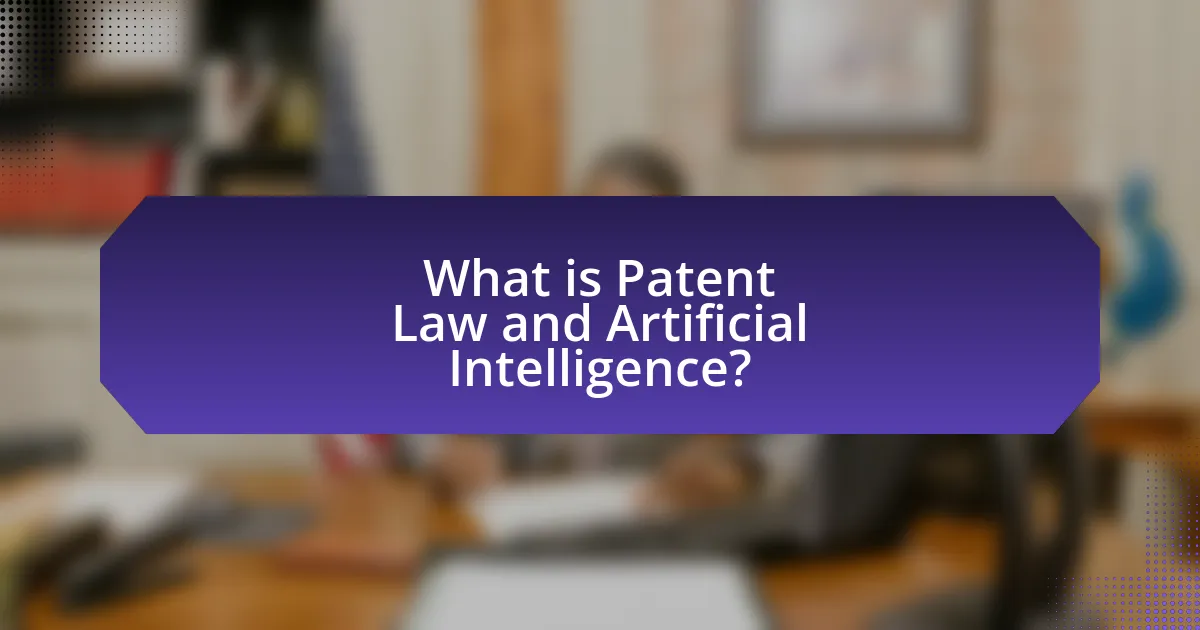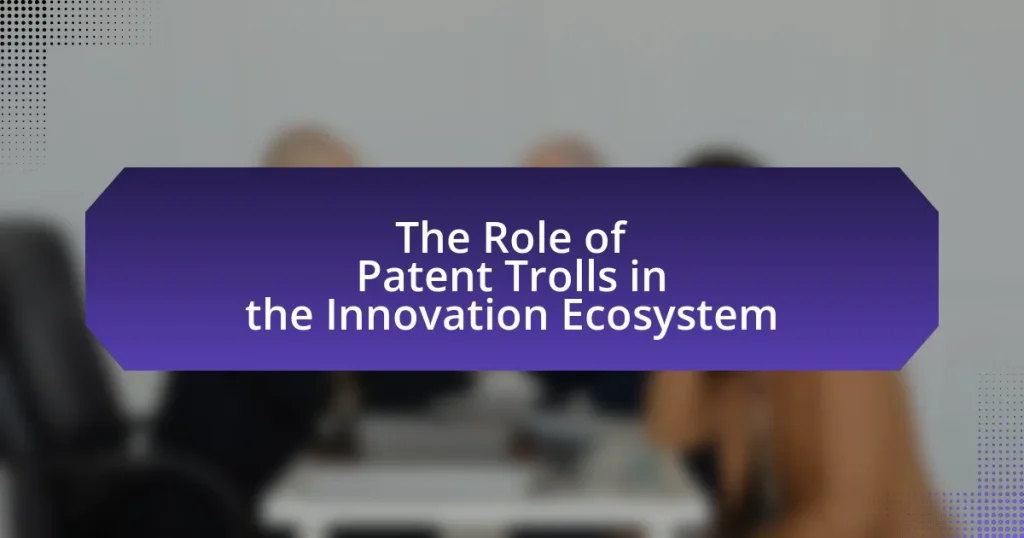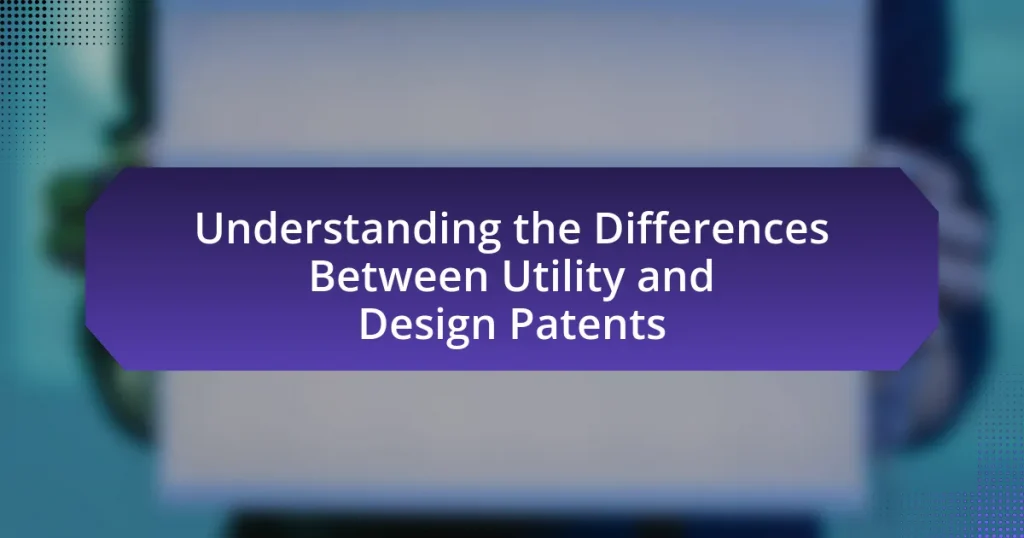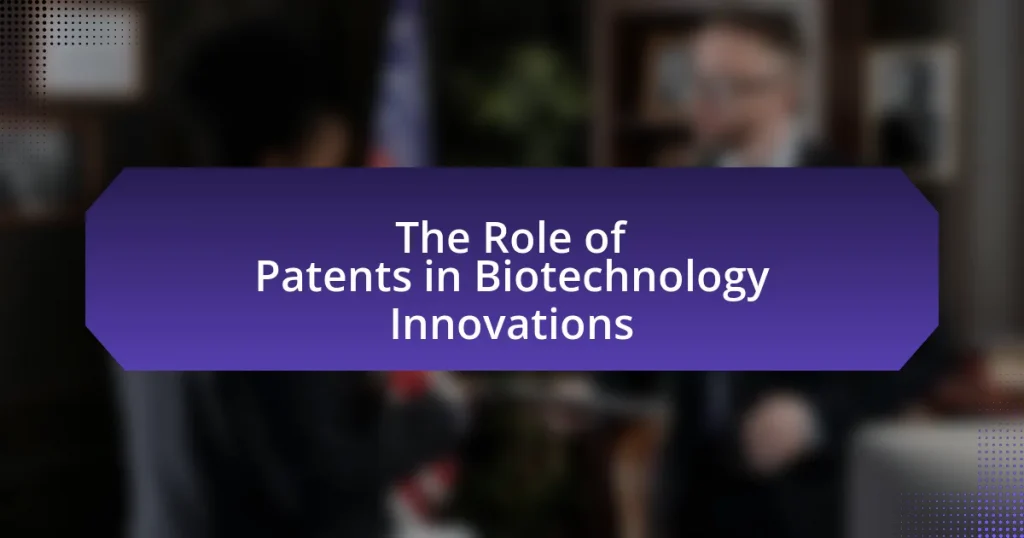The article examines the intersection of patent law and artificial intelligence (AI), focusing on the complexities surrounding the ownership and patentability of inventions generated by AI systems. It highlights that current patent laws typically require a human inventor, complicating the legal status of AI-generated inventions and raising questions about intellectual property rights. Key topics include the definition of AI inventions, the differences between AI and human inventors, and the implications of recent legal rulings on patent rights. The article also discusses the challenges of determining ownership, the need for legal reforms, and the ethical considerations involved in recognizing AI as an inventor.

What is Patent Law and Artificial Intelligence?
Patent law governs the protection of inventions, including those created by artificial intelligence (AI). AI can generate inventions autonomously, raising questions about the ownership and patentability of such creations. Current patent laws typically require a human inventor, which complicates the legal status of AI-generated inventions. For instance, in 2020, the U.S. Patent and Trademark Office ruled that an AI system cannot be listed as an inventor on a patent application, emphasizing the necessity of human involvement in the patent process. This intersection of patent law and AI continues to evolve as technology advances and legal frameworks adapt.
How do patent laws apply to inventions created by artificial intelligence?
Patent laws currently do not explicitly recognize artificial intelligence as an inventor, which complicates the patentability of inventions created by AI. In many jurisdictions, including the United States and Europe, patent laws require a human inventor to be named on the patent application, as established by the U.S. Patent Act and the European Patent Convention. This means that inventions autonomously generated by AI systems may face challenges in obtaining patent protection unless a human can be identified as the inventor or the applicant. Legal precedents, such as the 2021 decision by the U.S. Patent and Trademark Office, affirm that AI cannot be listed as an inventor, reinforcing the necessity for human involvement in the patent process.
What defines an invention in the context of AI?
An invention in the context of AI is defined as a novel and non-obvious solution or method that utilizes artificial intelligence technology to solve a specific problem or improve a process. This definition aligns with patent law criteria, which require that an invention must be new, useful, and not obvious to someone skilled in the relevant field. For instance, the development of a machine learning algorithm that significantly enhances data processing efficiency can be considered an invention if it meets these criteria. The U.S. Patent and Trademark Office recognizes AI-driven innovations as patentable, provided they fulfill the established requirements of novelty and utility.
How is AI’s role in invention different from human inventors?
AI’s role in invention differs from human inventors primarily in its reliance on data and algorithms rather than personal experience and creativity. While human inventors draw upon their unique insights, emotions, and contextual understanding to create novel ideas, AI systems generate inventions based on patterns identified in vast datasets, lacking the subjective experience that informs human creativity. For example, AI can analyze millions of existing patents to identify gaps or opportunities for innovation, but it does not possess the intrinsic motivation or emotional context that often drives human inventors. This fundamental difference raises questions about ownership and patent rights, as traditional patent law is designed around human inventors who can claim personal authorship and intent.
Why is ownership of AI-generated inventions a contentious issue?
Ownership of AI-generated inventions is contentious due to the ambiguity surrounding intellectual property rights and the legal status of AI as an inventor. Current patent laws typically require a human inventor, creating challenges when inventions are autonomously generated by AI systems. For instance, in 2020, the U.S. Patent and Trademark Office ruled that an AI cannot be listed as an inventor on a patent, which raises questions about who should hold the rights to such inventions—developers, users, or the AI itself. This legal uncertainty complicates the commercialization of AI innovations and raises ethical concerns about accountability and recognition in the innovation process.
What are the implications of AI inventorship on patent rights?
AI inventorship raises significant implications for patent rights, primarily challenging the traditional legal framework that assigns inventorship to human individuals. Current patent laws, such as the U.S. Patent Act, define an inventor as a natural person, which creates ambiguity regarding the status of inventions generated autonomously by AI systems. This ambiguity can lead to disputes over patent ownership, as entities may struggle to claim rights to inventions produced without direct human input.
For instance, in the case of the AI system DABUS, which generated novel inventions, courts in various jurisdictions have ruled that AI cannot be listed as an inventor under existing laws, thereby limiting the ability to secure patent protection for AI-generated innovations. This situation highlights the need for legal reforms to address the evolving role of AI in the inventive process and to clarify the rights of entities that utilize AI technologies in their innovation strategies.
How do different jurisdictions approach AI and patent ownership?
Different jurisdictions approach AI and patent ownership with varying legal frameworks and interpretations. In the United States, patent law allows for inventions created by AI to be patented, but the inventor must be a human, as established by the U.S. Patent and Trademark Office guidelines. In contrast, the European Union is exploring the concept of AI as an inventor, with ongoing discussions about potential amendments to existing laws to accommodate AI-generated inventions. Meanwhile, countries like Australia have recognized the need for clarity, as seen in the 2021 Federal Court ruling that acknowledged AI could be listed as an inventor, although the patent rights still reside with a human owner. These differences highlight the evolving nature of patent law in relation to AI across jurisdictions, reflecting diverse legal interpretations and the need for harmonization in global patent systems.
What challenges arise in determining ownership of AI inventions?
Determining ownership of AI inventions presents challenges primarily due to the ambiguity surrounding the legal status of AI as an inventor. Current patent laws, such as those in the United States and Europe, typically require a human inventor, which complicates the recognition of AI-generated inventions. For instance, in 2020, the U.S. Patent and Trademark Office ruled that an AI system cannot be listed as an inventor on a patent application, reinforcing the notion that only human inventors can hold ownership rights. This legal framework creates uncertainty regarding who should be credited for inventions produced by AI, whether it be the developers, users, or the AI itself. Additionally, the rapid advancement of AI technology outpaces existing legal definitions and frameworks, leading to further complications in establishing clear ownership rights.
How does the lack of legal precedent affect AI patent ownership?
The lack of legal precedent significantly complicates AI patent ownership by creating uncertainty regarding the rights of inventors and the applicability of existing patent laws. Without established case law, courts and patent offices face challenges in determining whether AI-generated inventions can be attributed to human inventors or if the AI itself can hold ownership. This ambiguity can lead to disputes over patent rights, as seen in cases where companies have attempted to patent AI-generated innovations without clear guidelines on ownership. Consequently, the absence of legal precedent may hinder innovation, as inventors and companies may be reluctant to invest in AI technologies due to fears of potential legal challenges and unclear intellectual property protections.
What ethical considerations are involved in AI-generated inventions?
AI-generated inventions raise several ethical considerations, primarily concerning authorship, accountability, and the implications of intellectual property rights. The question of authorship arises because traditional patent law attributes invention to human inventors, yet AI systems can autonomously create novel solutions. This challenges existing frameworks, as it is unclear whether AI should be recognized as an inventor or if the credit should go to the developers or users of the AI.
Accountability is another critical ethical concern; if an AI-generated invention causes harm or infringement, determining liability becomes complex. For instance, if an AI creates a product that violates existing patents, the responsibility for legal repercussions may not be straightforward.
Additionally, the implications of intellectual property rights must be considered, as granting patents for AI-generated inventions could lead to monopolization of technology, stifling innovation and competition. The ethical dilemma here involves balancing the encouragement of technological advancement with the need to maintain fair access to innovations.
These considerations highlight the need for a reevaluation of patent laws to address the unique challenges posed by AI-generated inventions.

How does current patent law address AI-generated inventions?
Current patent law generally does not recognize AI as an inventor, requiring a human inventor to be named on patent applications. This is evidenced by decisions from patent offices, such as the United States Patent and Trademark Office (USPTO) and the European Patent Office (EPO), which have ruled that only natural persons can be listed as inventors. For instance, in 2021, the USPTO rejected a patent application that named an AI system as the inventor, reinforcing the requirement for a human inventor. This legal framework raises questions about ownership and rights associated with inventions generated by AI, as existing laws do not accommodate the unique nature of AI-generated innovations.
What are the existing legal frameworks for AI inventions?
The existing legal frameworks for AI inventions primarily include patent law, copyright law, and trade secret law. Patent law governs the protection of inventions, including those generated by AI, under the premise that the inventor must be a human. The U.S. Patent and Trademark Office (USPTO) and the European Patent Office (EPO) have issued guidelines indicating that AI-generated inventions can be patented if they meet the criteria of novelty, non-obviousness, and utility, but the inventor must be a human. Copyright law protects original works of authorship, which can include AI-generated content, but the authorship is typically attributed to the human operator or programmer. Trade secret law protects confidential business information, which can encompass algorithms and data used by AI systems. These frameworks are evolving as legal systems adapt to the increasing role of AI in innovation.
How do these frameworks differ across countries?
Patent law frameworks differ significantly across countries in their treatment of artificial intelligence inventions. For instance, the United States allows for broader patentability of AI-generated inventions under the Patent Act, which does not explicitly exclude non-human inventors, while the European Patent Office requires that an inventor be a natural person, limiting the scope of AI-generated patents. Additionally, countries like China have rapidly adapted their patent laws to encourage AI innovation, offering expedited examination processes for AI-related patents, contrasting with the more cautious approaches seen in jurisdictions like the European Union, where ethical considerations are increasingly influencing patentability criteria. These differences reflect varying national priorities regarding innovation, economic strategy, and ethical implications of AI technology.
What recent cases have influenced AI patent law?
Recent cases that have influenced AI patent law include the U.S. Patent and Trademark Office’s decision in 2021 to deny a patent application filed by an AI system named DABUS, which was argued to be the inventor. This case highlighted the ongoing debate about whether non-human entities can be recognized as inventors under current patent laws. Additionally, the Federal Circuit’s ruling in 2022 reaffirmed that only natural persons can be designated as inventors, further shaping the legal landscape surrounding AI-generated inventions. These cases underscore the complexities and evolving nature of patent law as it intersects with advancements in artificial intelligence technology.
What reforms are being proposed to adapt patent law for AI?
Reforms proposed to adapt patent law for AI include clarifying the criteria for patentability, specifically addressing the role of AI in the inventive process. These reforms aim to determine whether inventions generated by AI systems can be patented and who holds the rights to such patents. For instance, discussions are ongoing about whether to recognize AI as an inventor or to maintain that only human inventors can be credited, as seen in cases like the DABUS patent application. Additionally, there is a push for updating the definitions of “inventor” and “invention” in patent statutes to encompass AI-generated outputs, ensuring that the legal framework keeps pace with technological advancements.
How might these reforms impact innovation in AI?
Reforms in patent law can significantly enhance innovation in AI by providing clearer guidelines on intellectual property rights for AI-generated inventions. These reforms can encourage investment in AI research and development by ensuring that creators and companies can protect their innovations, thus fostering a more competitive environment. For instance, the introduction of specific provisions for AI-generated inventions can lead to increased patent filings, as evidenced by the rise in patent applications related to AI technologies, which grew by over 25% annually from 2015 to 2020 according to the World Intellectual Property Organization. This legal clarity can stimulate collaboration between researchers and industry, ultimately accelerating the pace of technological advancements in AI.
What role do stakeholders play in shaping these reforms?
Stakeholders play a crucial role in shaping reforms in patent law related to artificial intelligence by influencing policy decisions, advocating for specific interests, and providing expertise. Their involvement ensures that diverse perspectives, including those from technology developers, legal experts, and industry representatives, are considered in the reform process. For instance, stakeholders often participate in public consultations and legislative hearings, where they present data and case studies that highlight the implications of AI on innovation and intellectual property rights. This engagement helps to create a balanced framework that addresses the complexities of ownership and patentability in the context of AI inventions.

What practical considerations should inventors keep in mind regarding AI and patents?
Inventors should consider the legal status of AI-generated inventions when applying for patents, as current patent laws may not clearly define ownership and inventorship in such cases. The U.S. Patent and Trademark Office (USPTO) has indicated that an inventor must be a human, which complicates the patentability of inventions solely generated by AI systems. Additionally, inventors must ensure that their AI systems do not infringe on existing patents, as the use of proprietary algorithms or datasets could lead to legal disputes. Furthermore, inventors should document the development process of their AI inventions meticulously, as this can provide evidence of originality and support patent claims.
How can inventors protect their AI-generated inventions?
Inventors can protect their AI-generated inventions by applying for patents, which grant exclusive rights to the inventor for a specified period. Patent law allows inventors to file for protection if their invention is novel, non-obvious, and useful. For AI-generated inventions, the inventor must demonstrate that they contributed to the creation process, as patent eligibility often requires human inventorship. The U.S. Patent and Trademark Office (USPTO) and other international patent offices have guidelines that address the complexities of AI in innovation, emphasizing the need for a clear human role in the invention.
What steps should be taken to secure patent rights for AI inventions?
To secure patent rights for AI inventions, the inventor must first ensure that the invention meets the criteria of patentability, which includes novelty, non-obviousness, and usefulness. The inventor should then conduct a thorough prior art search to confirm that the invention has not been previously disclosed or patented. Following this, the inventor must prepare a detailed patent application that clearly describes the AI invention, including its technical specifications and potential applications. This application should be filed with the relevant patent office, such as the United States Patent and Trademark Office (USPTO), and may require the assistance of a patent attorney to navigate complex legal requirements. Finally, the inventor should monitor the application process and respond to any office actions or requests for additional information from the patent office to ensure successful patent issuance.
What common pitfalls should inventors avoid in the patent process?
Inventors should avoid several common pitfalls in the patent process, including inadequate documentation of the invention, failing to conduct a thorough prior art search, and neglecting to file for patent protection in a timely manner. Inadequate documentation can lead to difficulties in proving the originality and details of the invention, which is crucial for patent approval. A thorough prior art search is essential to ensure that the invention is novel and not already patented, as this can save time and resources. Additionally, timely filing is critical because delays can result in losing patent rights, especially in jurisdictions that operate on a first-to-file basis. These pitfalls can significantly hinder the patent process and the inventor’s ability to protect their intellectual property effectively.
What best practices can guide inventors in navigating AI patent law?
Inventors can navigate AI patent law effectively by understanding the nuances of patent eligibility, ensuring their inventions meet the criteria of novelty, non-obviousness, and utility. Familiarity with the specific requirements set forth by patent offices, such as the United States Patent and Trademark Office (USPTO), is crucial, as they provide guidelines on how AI-related inventions can be patented. For instance, the USPTO has issued guidance indicating that AI-generated inventions may be patentable if they demonstrate a clear human contribution and are not merely the result of an automated process. Additionally, inventors should document their development process meticulously, as this can support claims of originality and innovation during the patent application process. Engaging with legal experts specializing in intellectual property can also provide tailored advice and help navigate complex legal landscapes, ensuring compliance with evolving regulations in AI patent law.
How can collaboration with legal experts enhance patent strategies?
Collaboration with legal experts enhances patent strategies by providing specialized knowledge in intellectual property law, which is crucial for navigating complex patent landscapes. Legal experts can identify potential patentable innovations, assess the strength of existing patents, and ensure compliance with legal requirements, thereby reducing the risk of infringement. For instance, a study by the World Intellectual Property Organization indicates that companies with legal counsel involved in their patent processes experience a 30% higher success rate in patent applications. This collaboration also aids in crafting robust patent claims that can withstand legal scrutiny, ultimately leading to stronger protection of innovations in the rapidly evolving field of artificial intelligence.
What resources are available for understanding AI patent law?
Resources available for understanding AI patent law include academic journals, legal textbooks, and online databases. Notable academic journals such as the “Harvard Journal of Law & Technology” and the “Stanford Technology Law Review” publish articles specifically addressing the intersection of AI and patent law. Legal textbooks like “Patent Law and Theory: A Handbook” provide foundational knowledge and case studies relevant to AI inventions. Online databases such as Google Scholar and Westlaw offer access to a wide range of legal articles, case law, and patent filings that can enhance understanding of current trends and legal interpretations in AI patent law.



